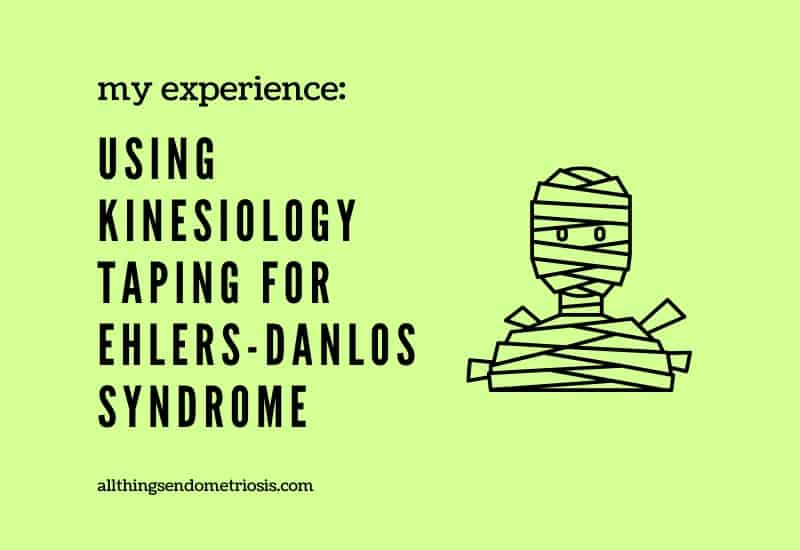
There are various pain management techniques for Ehlers-Danlos Syndrome and neuromuscular kinesiology taping is one of them. Here is how I discovered taping and I’ve included a video that shows how my taping is done.
Pain Management for Ehlers-Danlos Syndrome
There are various forms of pain management for Hypermobile Ehlers-Danlos Syndrome patients.
I am not a medical expert and as I am actively dealing with the hypermobile sub-type, I can only speak of pain management techniques that I have experienced.
Here goes…
1. Change in Diet
Creating an anti-inflammatory diet is a great way to support your body in its fight against pain. I have written about it in detail right here.
2. Natural Pain Relief Methods
I have spoken of such methods in my piece here about endometriosis but these can apply to those with Ehlers-Danlos Syndrome.
3. Hot Water
Although I have mentioned this in my natural pain relief list found in the link above. I wish to add a few important pointers.
Hot water aids by calming cramping muscles and helps reduce pain, whether I do this through a hot water bottle or by soaking myself in hot water, it’s been helpful.
Here’s what I would like to add. If you are soaking yourself or a particular joint in hot water, do add some epsom salt – it is believed (although not proven) that epsom salt soothes the joints and helps to reduce swelling.
If you’re not allergic to epsom salt and your doctor approves, then it may be worth giving a go. If not, then hot water bottles are great too.
3. Physiotherapy – Resistance Bands
This is a tool that helps build muscle strength. There are various resistance grades available which suit various strength levels.
This allows you to begin at a very mild level as explained and advised by your physiotherapist because building muscle strength little by little helps improve joint support and reduce pain levels.
But of course, everything under the advice of your physiotherapist.
Read Here For:
- My Experience: The Relation Between Endometriosis / EDS and Chronic Fatigue
- My Experience: Connecting Endometriosis and Ehlers-Danlos Syndrome
4. Aquatherapy
Any form of strength training that assists the muscles receiving support which in-turn reduces the regularity of pain and flare-ups gets my vote as a form of viable therapy.
Aquatherapy is conducted in warm water with the guidance of a therapist taking you through the exercises.
Our body-weight is supposed to reduce by 80% in water which is a massive reduction in the load your body would feel otherwise while attempting to do the same exercises.
I will write about this therapy and my experiences with it in greater detail in the weeks to come.
5. Kinesiology Taping
This is what we’re going to talk about today. Read on for more details.
View this post on Instagram
I knew I could not be dependent on medication because that led to drowsiness which contributed to my POTS worsening which meant an increase in falls.
I came across a series of webinars by Dr Pradeep Chopra – a pain management specialist and someone who looks into Ehlers-Danlos Syndrome caused pain… and no I’m not related to him! 😀
In one of his webinars, he speaks about neuromuscular taping. So first,…
What is Neuromuscular Kinesio Taping?
As explained by Dr Chopra, Neuromuscular Kinesio tape is a like a superficial layer of skin in an adhesive fabric form with a finger-print type pattern on it.
I’ve tried various tapes – Kinesiology tape, Dynamic tape, Move Kinetic tape and Thrive tape – they’re all made of different mixtures of fabric and have different stretch percentages.
For example, Dynamic tape is strong yet stretches all four ways and Move Kinetic tape is hypoallergenic and stretches two ways.
Because of my skin sensitivity from having Ehlers-Danlos, the tape used is based on how my skin is doing on that particular taping day.
These tapes are usually water resistant so you can keep them on for a few days before they lose their hold.
But, I hear you ask…
How Does Kinesiology Taping Help Ehlers-Danlos Patients?
Dr Chopra explains that taping helps reduce swelling, stabilises joints and improves pain.
Personally I’ve found that by taping my ankles and knees the joint stability felt generates confidence when I walk and also gives me the compression I crave for.
Before I was introduced to taping and on current non-taping days, I usually bandage my shins and ankles because they provide warmth and compression.
But on taping days, I don’t feel the need for this – I experience comforting compression and reduced pain throughout the day and night for at least 3 to 4 days after taping.
To understand more, you can watch that section here and in fact all of Dr Chopra’s videos in this series are very helpful.
How is Kinesiology Taping Done?
I get taping done from my physiotherapist for my shins, ankles, knee, ribs, wrist, arm, elbow, jaw – yes some days I am THAT taped up!
I’ve created a video explaining how some of the taping is done in further detail.
I take professional help and I know Dr Chopra does say in his video that you can do this yourself and I know many who do – but it’s always best to learn from a physiotherapist that knows taping – someone who can show you exactly what you need.
Watch here for my taping:
I hope this post on taping helps. It’s proved to improve my quality of life and at the end of it, that’s all one can strive towards when dealing with a chronic illness.
If you have pain management techniques that you would like to share then please do leave your suggestions in the comment section below – thank you 🙂
If you’re a social media person, then you can follow me on Instagram, Twitter, Facebook, Pinterest or YouTube.
I have a podcast too. You can check them out here along with their transcripts or if you don’t wanna read them then they’re available on Spotify and Apple Podcasts too.
~~~~~~~
Disclaimer: I am not a medical professional. I am a patient and have created this platform to share my experiences. This is all purely informative and in no way am I providing medical advice. Please consult a medical professional.


I had taping for my knee years ago, but have fallen off the wagon with it. I really must ask my new physiotherapist about it as my knee is definitely caving in a little as I walk. Thanks for the reminder Shruti!
I am so curious to try this. I have compression wraps, but not tape. I think it would help immensely with my legs and with my left shoulder/arm. The problem is finding the right tape. Based on your info, it sounds like the stuff that stretches two ways is what I need. (Based on the fact that I seem to react to most types of tapes!) Thanks so much for the great information and instructional videos. I hope it is ok to say that I think your taping techniques always look beautiful!
Thank you so much for adding the closed captioning type of notes to your videos! ❤️
Hi Tiffany
In all my recent videos, I have done my best to add captions. This video had me adding it to the actual video, but now on YouTube I just upload the captions. I feel it’s so important to do. Thank you for dropping by 🙂
I just stuck on my first kinesiology tapes yesterday! Definitely still a noob – looked like a mummy heh. THanks for these tips! I hope to experiment with it and see if it helps. Quite pricey though if I got to keep ‘setting it up’ every day.